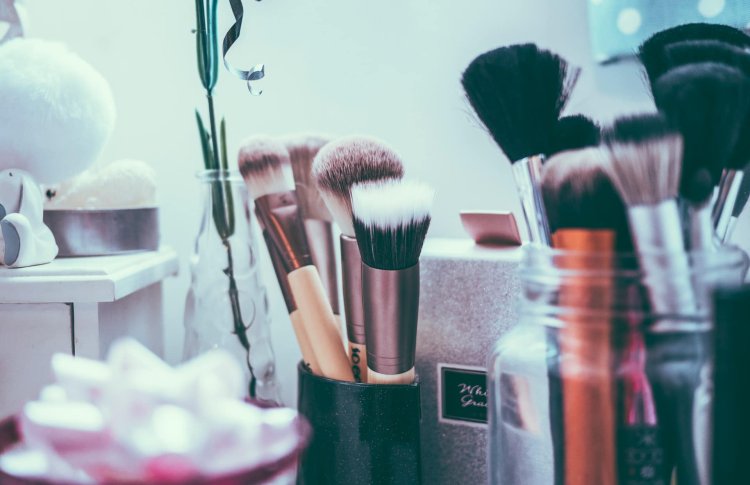Tricks to organize make up in one place
Now honestly: is there anything better (other than a Friday night cocktail or possibly world peace of mind) than the perfect row in the makeup heap you bought that summer

Now honestly: is there anything better (other than a Friday night cocktail or possibly world peace of mind) than the perfect row in the makeup heap you bought that summer when you set out to start your career as a beauty blogger? Probably not, especially if you belong to that group (welcome to us) who have been looking at their dirty and dry make up sponge for two months with the thought: "Tomorrow I will definitively do it."
We do not judge you, we just think about your mental health and the fact that just getting things in order affects a good mood. Moreover, a good organization is a key part of self-care, and that is why we have dived into piles of tips to dig up the most useful ones for you and achieve a much-needed zen together with you.
Step 1: Officially declare a major cleanup
Start by checking deadlines on bottles
"Unfortunately for us, make up also has an expiration date, and when it expires, the effect of active ingredients and preservatives is lost," says cosmetic chemist Ron Robinson. In other words, your make up will no longer be of equal quality, and you also risk numerous skin irritations or infections.
If you can't find a date on a product, check your order history or try to remember when you bought it. "In general, you should throw away everything you apply near your eyes within three to six months, and all lip products after a year," Robinson explains.
Liquid and creamy face products (such as powder and blush) will last up to a year after opening, and we can use dry products for up to 18 months.
Throw out anything that looks or smells weird
Even if the date on the bottle indicates otherwise, due to exposure to air and dirt, some products could spoil even before the expected deadline. Therefore, if you notice that the color of the powder has changed, or the texture seems different to you than before, immediately get rid of this product.
The same applies to favorite brushes and sponges. "The sign that the brushes are ready to be replaced is usually a significant hair loss or the fact that their shape does not return to their original state after washing," says Marc Reagan, director of education and events at Hourglass Cosmetics.
Get rid of products you'll never use
What about that squeamish purple lipstick you got in the free package in 2017? What about that giant palette you had to have that you haven't even opened yet? Don't hate us, but just like that sequined jacket in your closet that hasn't seen the light of day since 2015, that make up has been sentenced to life in prison in your drawers. "But what if one day I still need it?" Well, it's this mentality that's a one-way ticket to Messtown, and now it's officially time to admit it to yourself. Don't worry, no one said all that makeup had to end up in the trash. Moreover, single out products that are good but simply not for you and give them to a friend, sister or mom, a person you know will be happy to use them.
"It may sound strange to you, but it's time to encourage yourself to clean your make up every six months with a reminder in the calendar," says Helen Phillips, Sephora Collection national make-up artist. Translation - take out everything, clean or simply throw away.
Step 2: Wash and disinfect everything that's left
After reliving 2020, we know that you know what it means to disinfect. And just as you have become accustomed to disinfecting all the knobs, why not do it with the products you put on your face? Specifically, as many as 90 percent of the items in the average cosmetic bag contain bacteria, such as staphylococcus or E. coli. It's really high time we went to the cleaners...
... your tools
If anyone asks you, makeup brushes and sponges should generally be cleaned after each use. Unofficially, no one has time for that. "Spray your brushes with 70% alcohol between uses," advises Phillips. However, once a month, take the time to deeply clean with warm water and shampoo for brush washing or gentle, baby shampoo. If you prefer sponges, which are a kind of nest of bacteria, wash them at least once every two weeks using a quality shampoo, such as Real Techniques gel for cleaning brushes and sponges, and let them dry well before the next use.
... your products
Let's start with those for the eyes (because no one likes barley). You need to sew eyeliner at least once a week to remove the top layer. Then feel free to spray them with spray alcohol. Unfortunately, there is no way to clean lipsticks and concealers without making a mess, so spray them with alcohol. If your lipstick has fallen to the floor or you are convinced that you have contaminated it in some other way (for example, by lending it to your roommate), remove the upper part with a knife. Also, clean the packages in which the makeup is located with a wet disinfectant wipe.
Step 3: Find the system that will work best for you
If you enjoy minimalism:
Get rid of the old plastic bag in which you keep makeup and choose a leather handbag instead that will protect it, and the whole collection will be neat and clear at the same time. To make sure everything stays clean and disinfected, separate the make up products from sponges and tools. In addition, make sure that you only wear those products that you use daily. Move the rest to a separate compartment or purse to avoid re-accumulation of clutter and dirt.
If they haven't produced a handbag big enough for your collection yet:
First of all, do not spend money on huge plastic boxes that perfectly fulfill the role of a black hole for your favorite make up. Instead, get transparent organizers for drawers where you can easily identify all the products you want. If you are really determined to arrange a personal make up corner, make sure that the drawers are high enough so that the powders in them can stand vertically, but also wide enough that you can arrange all the pallets, boxes and compact powders in them.
Also, if you are tired of searching for products in a sea of eye, eyebrow and lip pens, reserve each tray for a specific purpose: arrange lipsticks, glosses and lip pencils in one, arrange the other for eye products, etc.
If you continue to persevere with your influencer career:
We will assume that your make up collection contains enough products to open a small shop. Don't get us wrong, we're envious! We advise you to turn to Pinterest and start decorating your own make up corner. Put visually appealing things, such as limited edition palettes or beautiful brushes, in plain sight (who says makeup can't serve decorative purposes?) along with scented candles, vases and other details that will make your corner a real oasis on Instagram. Hide other products (such as eye pens you bought even before you had a four-digit number of followers) in an invisible but convenient place on the bottom shelves and organize the ones you use neatly in the most accessible places every day.
The top shelf is reserved for all those products that you have not yet had time to try, but you definitely intend, as well as those waiting for next season. The same rule applies to products you have too many of: "You don't need 50 black eye pencils," Phillips says. "Keep on hand the ones you use every day. Mark and dispose of the others in a safe and clean place."
3 golden rules of the organization of make up:
1 Make up does not like sunlight
Although we love catching the sun's rays for that perfect selfie, direct exposure to the sun will result in a loss of color and melting of creamy products, which accelerates spoilage.
2 Bathroom is your enemy
It may seem like a logical place to store it, but the wettest room in your home is perfect for the development of bacteria and fungi, which is why you will say goodbye to your favorite products much faster than you planned.
3 Close the caps and lids well
"Not only to prevent leakage but also to maximize the exposure of products to the air," Reagan explains. This rule applies specifically to examples and BB creams containing antioxidants and other skin care ingredients.





























